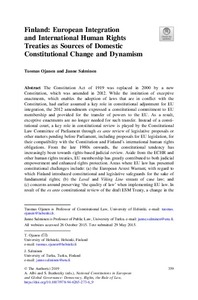Finland: European Integration and International Human Rights Treaties as Sources of Domestic Constitutional Change and Dynamism
Janne Salminen; Tuomas Ojanen
https://urn.fi/URN:NBN:fi-fe2021042715124
Tiivistelmä
The Constitution Act of 1919 was replaced in 2000 by a new Constitution, which was amended in 2012. While the institution of exceptive enactments, which enables the adoption of laws that are in conflict with the Constitution, had earlier assumed a key role in constitutional adjustment for EU integration, the 2012 amendments expressed a constitutional commitment to EU membership and provided for the transfer of powers to the EU. As a result, exceptive enactments are no longer needed for such transfer. Instead of a constitutional court, a key role in constitutional review is played by the Constitutional Law Committee of Parliament through ex ante review of legislative proposals or other matters pending before Parliament, including proposals for EU legislation, for their compatibility with the Constitution and Finland’s international human rights obligations. From the late 1980s onwards, the constitutional tendency has increasingly been towards rights-based judicial review. Aside from the ECHR and other human rights treaties, EU membership has greatly contributed to both judicial empowerment and enhanced rights protection. Areas where EU law has presented constitutional challenges include: (a) the European Arrest Warrant, with regard to which Finland introduced constitutional and legislative safeguards for the sake of fundamental rights; (b) the Laval and Viking Line stream of case law; and (c) concerns around preserving ‘the quality of law’ when implementing EU law. In result of the ex ante constitutional review of the draft ESM Treaty, a change in the draft treaty stemming from constitutional concerns about increased financial liabilities without parliamentary control was proposed and achieved.
Kokoelmat
- Rinnakkaistallenteet [19207]
